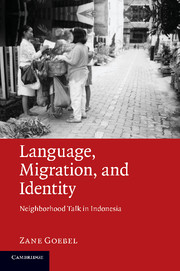Book contents
- Frontmatter
- Contents
- Figures
- Diagrams
- Maps
- Tables
- Extracts
- Preface
- Conventions
- 1 Introduction
- 2 Long-term Processes of Enregisterment
- 3 Enregistering Local Practices and Local Spaces
- 4 Linguistic Signs, Alternation, Crossing, and Adequation
- 5 Women, Narratives, Identity, and Expectations in Ward 8
- 6 Learning to Become a Good Ward Member
- 7 Emerging Identities in a Monthly Ward 8 Male Meeting
- 8 Chineseness as Deviance
- 9 Language Ideologies and Practice in Ward 5
- 10 Conclusions
- Notes
- References
- Index
8 - Chineseness as Deviance
Published online by Cambridge University Press: 04 August 2010
- Frontmatter
- Contents
- Figures
- Diagrams
- Maps
- Tables
- Extracts
- Preface
- Conventions
- 1 Introduction
- 2 Long-term Processes of Enregisterment
- 3 Enregistering Local Practices and Local Spaces
- 4 Linguistic Signs, Alternation, Crossing, and Adequation
- 5 Women, Narratives, Identity, and Expectations in Ward 8
- 6 Learning to Become a Good Ward Member
- 7 Emerging Identities in a Monthly Ward 8 Male Meeting
- 8 Chineseness as Deviance
- 9 Language Ideologies and Practice in Ward 5
- 10 Conclusions
- Notes
- References
- Index
Summary
Introduction
In this chapter I continue to explore how Pak Kris's emerging identity as a stingy non-attending ward member solidifies in the routine meeting that occurred one month after the meeting discussed in Chapter 7. In doing so, I draw more heavily upon my ethnographic data. In particular, I point out how conversational activities in the January meeting co-occurred with local and wider events in a way that contributed to the co-construction and (re)production of particular categories of personhood. In Section 8.1 I start by showing how the financial situation of the ward and the financial status of its members is an important factor figuring in processes of social identification and in the (re)production of expectations for social conduct in this ward. In Section 8.2 I continue to look at the nexus between signs from different spatial-temporal settings to point out how they are used as resources to identify not only non-present others, but those doing this social identification. In doing so, I highlight how this process figures in the formation of two locally emerging semiotic registers (LESRs). One of the interesting things about one of these LESRs relates to linguistic sign usage, which contrasts with patterns of female sign exchange discussed in Chapter 6. In accounting for this contrast, I again look further into participants' trajectories of socialization within this ward (Section 8.3).
- Type
- Chapter
- Information
- Language, Migration, and IdentityNeighborhood Talk in Indonesia, pp. 147 - 171Publisher: Cambridge University PressPrint publication year: 2010

